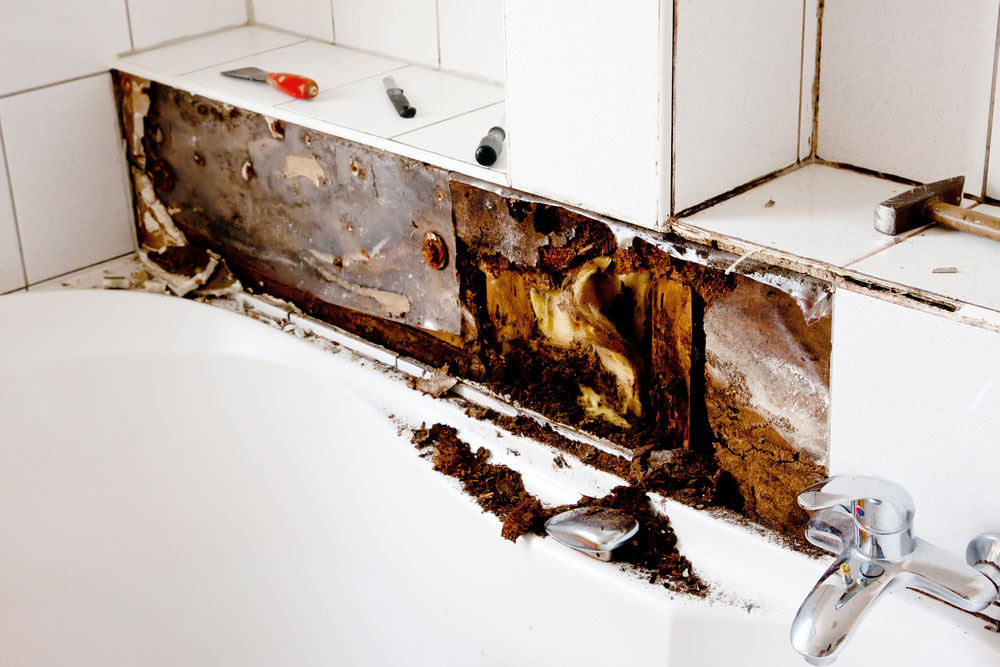What're your insights and beliefs on How to Fix a Water Damage Bathroom?

The restroom is incredibly prone for damp build-up and also prospective water damages as a result of the regular use water in it. This write-up offers simple inspection techniques to assist discovering water damages dangers.
The constant use water in the washroom makes it extremely at risk for wet buildup and also possible water damages. By evaluating it regularly, you can reduce water related problems.
The following collection of assessments is very easy to execute and also need to be done when in every 3 months in order to maintain your washroom healthy and also to stop potential water damages caused by the bathtub, the shower, pipe joints and plumbing, sinks, cabinets, and the toilet
Do not overlook performing these evaluations and be extensive while doing them. Bear in mind that these easy inspections can save you a lot of money by giving very early signs for water damages
Bath tub as well as Shower
The shower as well as tub require special focus as well as maintenance. Examine the floor tiles as well as replace if fractured. Make certain that there is no missing grout in between the ceramic tiles. Examine and also change broken caulking at joints where the walls fulfill the floor or the bathtub. Obstructed drains and pipelines issues will protect against the tub from drying and also may show severe problems under the tub. Speak with a specialist promptly to prevent architectural damage. Pay attention to discolorations or soft locations around the bathtub walls as they might indicate an inner leak.
Plumbing
Signs for water damage are hard to spot given that a lot of pipes are set up inside the walls.
Pay unique attention to floor covering and wall surfaces moisture and also stains as they might indicate an unseen plumbing problem. Examine moisture degrees in adjoining spaces too.
Sinks as well as Cabinets
Sinks and also cabinets are revealed to moisture as well as moisture everyday and also are frequently forgotten. Examine on a regular basis under the sink and also on the countertop over it. Repair any kind of drip in the trap as it might suggest drainpipe problems. Browse the sink, slow-moving draining pipes might indicate an obstructed drain. Change sink seals if they are cracked or loosened.
The Commode
The bathroom is an at risk water junction. Inspect the water lines and also search for leakages around the toilet seat, in the pipe, as well as under the water tank. If you discover any kind of signs of dampness on the floor around the bathroom, look for leaks in the toilet rim and also tank seals.
Know that hanging commode bowl antiperspirants raises the chances for blockages.
Water Damage Signs In The Bathroom To Avoid Cleanup
Musty smell
This is one of the easiest signs to catch because musty smells are so odorous. The damp, earthy, moldy smell should be a big red flag. The smell will develop when moisture gets trapped in surfaces, and begins to facilitate mold growth. Leaking pipes under cabinets, inside walls, and behind shower fixtures will cause moisture to stay trapped and not dry, which will lead to mold growth and spread. As soon as you notice any musty smells in your bathroom, have it checked for hidden water damage and cleanup signs.
Visible mold
If the smell isn’t there to give it away, sometimes you will actually see mold growth. Finding mold in your bathroom is a serious problem, because mold is very harmful to your health. By the time mold growth is visible, it also means that water damage has already occurred and been present for some time. The only way the mold problem can be resolved is to find the source of the moisture and get it stopped. To safely and adequately remove mold, you need to have professionals handle the remediation. Do not waste any time in getting mold problems addressed, fixed, and sanitized so that you can protect you and your family from the many respiratory symptoms caused by mold exposure.
Damaged floors
Bathroom floors should be able to withstand some exposure to water while still remaining in good condition. However, when excess exposure or water leaks occur, they will begin to damage even the most water-resistant flooring. If you notice any cracking, bubbling, staining, or warping on your bathroom floors, there is probably a water leak somewhere causing the distortion. If you notice areas of the floor have become softer, or even have a spongy feeling, there is probably damage to the subfloor. Subflooring is typically made up of plywood. When plywood is exposed to water or moisture, it will absorb it. Once it has become saturated, the weight of the excess water will cause the wood to swell and soften. Check the floors in your bathroom frequently to catch any of these sings before they lead to damaged subflooring.
Changes on walls
When water leaks behind walls, it will cause changes in the drywall. Peeling plaster, blistering paint, and soggy wallpaper are all good indicators that excess water is building up behind the wall. Water leaking behind drywall will cause it to swell and be soft to the tough. If you start to notice gaps along the trim of your walls, or where tile meets the wall, it could also be a strong indicator that there is a leak behind the wall. Any changes, distortion, or damage on the walls should be evaluated as soon as you notice it to prevent further water damage and cleanup.

I recently found that post about Preventing Water Damage in the Bathroom while doing a search on the search engines. You should take a moment to distribute this page if you liked it. I treasure reading our article about How to Repair and Prevent Bathroom Water Damage.
Information Here